Insights into the Crustal Evolution and Tungsten Mineralization of the West Cathaysia Block: Constraints from the Inherited Zircons from the Mesozoic Dengfuxian and Paleozoic Tanghu Plutons, South China
Abstract
:1. Introduction
2. Regional Geology
3. Sampling and Analytical Methods
3.1. Sampling and Description
3.2. Analytical Methods
3.2.1. Selection and CL Imaging of Zircon
3.2.2. LA-ICP-MS Zircon U-Pb Dating
3.2.3. LA-MC-ICP-MS Zircon Lu-Hf Isotope Analysis
4. Results
4.1. Zircon Characteristics
4.2. Zircon U-Pb Isotopic Ages
4.3. Zircon Lu-Hf Isotopes
5. Discussion
5.1. Precambrian Crust Evolutionary History of the West Cathaysia Block
5.1.1. Archean (4000~2500 Ma)
5.1.2. Paleoproterozoic (2500~1600 Ma)
5.1.3. Mesoproterozoic-Neoproterozoic (1600~540 Ma)
5.2. Implications for the Regional Tungsten Mineralization
6. Conclusions
Supplementary Materials
Author Contributions
Funding
Institutional Review Board Statement
Informed Consent Statement
Data Availability Statement
Acknowledgments
Conflicts of Interest
References
- Thieblemont, D.; Delor, C.; Cocherie, A.; Lafon, J.M.; Goujou, J.C.; Balde, A.; Bah, M.; Sane, H.; Fanning, C.M. A 3.5 Ga granite–gneiss basement in Guinea: Further evidence for early archean accretion within the West African Craton. Precambrian Res. 2001, 108, 179–194. [Google Scholar] [CrossRef]
- Marschik, R.; Mathur, R.; Ruiz, J.; Leveille, R.; de Almeida, A.J. Late Archean Cu–Au–Mo mineralization at Gameleira and Serra Verde, Carajas mineral Province, Brazil: Constraints from Re–Os molybdenite ages. Miner. Depos. 2005, 39, 983–991. [Google Scholar] [CrossRef]
- Zheng, Y.F.; Zhang, S.B. Formation and evolution of Precambrian continental crust in South China. Chin. Sci. Bull. 2007, 52, 1–12, (In Chinese with English Abstract). [Google Scholar] [CrossRef]
- Yu, J.H.; O’Reilly, Y.S.; Wang, L.J.; Griffin, W.L.; Zhou, M.F.; Zhang, M.; Shu, L.S. Components and episodic growth of Precambrian crust in the Cathaysia Block, South China: Evidence from U–Pb ages and Hf isotopes of zircons in Neoproterozoic sediments. Precambrian Res. 2010, 181, 97–114. [Google Scholar] [CrossRef]
- Payne, J.L.; Hand, M.; Pearson, N.J.; Barovich, K.M.; McInerney, D.J. Crustal thickening and clay: Controls on O isotope variation in global magmatism and siliciclastic sedimentary rocks. Earth Planet. Sci. Lett. 2015, 412, 70–76. [Google Scholar] [CrossRef]
- Tang, M.; Chen, K.; Rudnick, R.L. Archean upper crust transition from mafic to felsic marks the onset of plate tectonics. Science 2016, 351, 372–375. [Google Scholar] [CrossRef] [Green Version]
- Bucholz, C.E.; Biasi, J.A.; Beaudry, P.; Ono, S. Sulfur isotope behavior during metamorphism and anatexis of Archean sedimentary rocks: A case study from the Ghost Lake batholith, Ontario, Canada. Earth Planet. Sci. Lett. 2020, 549, 116494. [Google Scholar] [CrossRef]
- Li, R.Y.; Ke, S.; Li, S.G.; Song, S.G.; Wang, C. Origins of two types of Archean potassic granite constrained by Mg isotopes and statistical geochemistry: Implications for continental crustal evolution. Lithos 2020, 368, 105570. [Google Scholar] [CrossRef]
- Xu, X.S.; O’Reilly, Y.S.; Griffin, W.L.; Deng, P.; Pearson, N.J. Relict proterozoic basement in the Nanling Mountains (SE China) and its tectonothermal overprinting. Tectonics 2005, 24, 1–16. [Google Scholar] [CrossRef]
- Li, X.H.; Li, Z.X.; Li, W.X. Detrital zircon U–Pb age and Hf isotope constrains on the generation and reworking of Precambrian continental crust in the Cathaysia Block, South China: A synthesis. Gondwana Res. 2014, 25, 1202–1215. [Google Scholar] [CrossRef]
- Xu, X.; O’Reilly, S.Y.; Griffin, W.L.; Wang, X.; Pearson, N.J.; He, Z. The crust of Cathaysia: Age, assembly and reworking of two terranes. Precambrian Res. 2007, 158, 51–78. [Google Scholar] [CrossRef]
- Zhao, J.H.; Zhou, M.F.; Yan, D.P.; Zheng, J.P.; Li, J.W. Reappraisal of the ages of Neoproterozoic strata in South China: No connection with the Grenvillian orogeny. Geology 2011, 39, 299–302. [Google Scholar] [CrossRef]
- Li, X.H.; Li, Z.X.; He, B.; Li, W.X.; Li, Q.L.; Gao, Y.Y.; Wang, X.C. The Early Permian active continental margin and crustal growth of the Cathaysia Block: In situ U–Pb, Lu–Hf and O isotope analyses of detrital zircons. Chem. Geol. 2012, 328, 195–207. [Google Scholar] [CrossRef]
- Charvet, J. The Neoproterozoic–Early Paleozoic tectonic evolution of the South China Block: An overview. J. Asian Earth Sci. 2013, 74, 198–209. [Google Scholar] [CrossRef] [Green Version]
- Zhang, S.B.; Zheng, Y.F. Formation and evolution of Precambrian continental lithosphere in South China. Gondwana Res. 2013, 23, 1241–1260. [Google Scholar] [CrossRef]
- Mao, J.R.; Li, Z.L.; Ye, H.M. Mesozoic tectono–magmatic activities in South China: Retrospect and prospect. Sci. China–Earth Sci. 2014, 57, 2853–2877. [Google Scholar] [CrossRef]
- Cao, J.Y.; Yang, X.Y.; Du, J.G.; Wu, Q.H.; Kong, H.; Li, H.; Wan, Q.; Xi, X.S.; Gong, Y.S.; Zhao, H.R. Formation and geodynamic implication of the Early Yanshanian granites associated with W–Sn mineralization in the Nanling Range, South China: An overview. Int. Geol. Rev. 2018, 60, 1744–1771. [Google Scholar] [CrossRef]
- Cao, J.Y.; Li, H.; Algeo, T.J.; Yang, L.; Tamehe, L.S. Two–stage magmatism and tungsten mineralization in the Nanling Range, South China: Evidence from the Jurassic Helukou deposit. Am. Mineral. 2021, 106, 1488–1502. [Google Scholar] [CrossRef]
- Cawood, P.A.; Zhao, G.C.; Yao, J.L.; Wang, W.; Xu, Y.J.; Wang, Y.J. Reconstructing South China in Phanerozoic and Precambrian supercontinents. Earth–Sci. Rev. 2018, 186, 173–194. [Google Scholar] [CrossRef] [Green Version]
- Yan, C.L.; Shu, L.S.; Faure, M.; Chen, Y.; Huang, R.B. Time constraints on the closure of the Paleo–South China Ocean and the Neoproterozoic assembly of the Yangtze and Cathaysia blocks: Insight from new detrital zircon analyses. Gondwana Res. 2019, 73, 175–189. [Google Scholar] [CrossRef] [Green Version]
- Yu, J.H.; O’Reilly, Y.S.; Zhou, M.F.; Griffin, W.L.; Wang, L.J. U–Pb geochronology and Hf–Nd isotopic geochemistry of the Badu Complex, Southeastern China: Implications for the Precambrian crustal evolution and paleogeography of the Cathaysia Block. Precambrian Res. 2012, 222–223, 424–449. [Google Scholar] [CrossRef]
- Yu, J.H.; Wang, L.J.; Griffin, W.L.; O’Reilly, S.Y.; Zhang, M.; Li, C.Z.; Shu, L.S. A Paleoproterozoic orogeny recorded in a long–lived cratonic remnant (Wuyishan terrane), eastern Cathaysia Block, China. Precambrian Res. 2009, 174, 347–363. [Google Scholar] [CrossRef]
- Xia, Y.; Xu, X.S.; Zhu, K.Y. Paleoproterozoic S– and A–type granites in southwestern Zhejiang: Magmatism, metamorphism and implications for the crustal evolution of the Cathaysia basement. Precambrian Res. 2012, 216–219, 177–207. [Google Scholar] [CrossRef]
- Zhao, L.; Zhou, X.W.; Zhai, M.G.; Santosh, M.; Geng, Y.S. Zircon U–Th–Pb–Hf isotopes of the basement rocks in northeastern Cathaysia block, South China: Implications for Phanerozoic multiple metamorphic reworking of a Paleoproterozoic terrane. Gondwana Res. 2015, 28, 246–261. [Google Scholar] [CrossRef]
- Yu, J.H.; Zhang, C.H.; O’Reilly, Y.S.; Griffin, W.L.; Ling, H.F.; Sun, T.; Zhou, X.Y. Basement components of the Xiangshan–Yuhuashan area, South China: Defining the boundary between the Yangtze and Cathaysia blocks. Precambrian Res. 2018, 309, 102–122. [Google Scholar] [CrossRef]
- Xu, Y.J.; Du, Y.S.; Huang, H.W.; Huang, Z.Q.; Hu, L.S.; Zhu, Y.H.; Yu, W.C. Detrital zircon of 4.1 Ga in South China. China Sci. Bull. 2012, 57, 4356–4362. [Google Scholar] [CrossRef] [Green Version]
- Xing, G.F.; Wang, X.L.; Wan, Y.S.; Chen, Z.H.; Jiang, Y.; Kitajima, L.; Ushikubo, T.; Gppon, P. Diversity in early crustal evolution: 4100 Ma zircons in the Cathaysia Block of southern China. Sci. Rep. 2014, 4, 5134. [Google Scholar] [CrossRef] [Green Version]
- Li, X.Y.; Zhang, J.P.; Xiong, Q.; Zhou, X.; Lu, X. Triassic rejuvenation of unexposed Archean–Paleoproterozoic deep crust beneath the western Cathaysia block, South China. Tectonophysics 2018, 724–725, 65–79. [Google Scholar] [CrossRef]
- Xiong, C.; Chen, H.D.; Niu, Y.L.; Chen, A.Q.; Zhang, C.G.; Li, F.; Xu, S.L.; Yang, S. Provenance, depositional setting, and crustal evolution of the Cathaysia Block, South China: Insights from detrital zircon U–Pb geochronology and geochemistry of clastic rocks. Geol. J. 2019, 54, 897–912. [Google Scholar] [CrossRef] [Green Version]
- Zheng, J.P.; Griffin, W.L.; Tang, H.Y.; Zhang, Z.H.; Su, Y.P.; Liu, G.L. Archean basement similar to the North China and Yangtze continents may be existed beneath the western Cathaysia. Geol. J. China Univ. 2008, 14, 549–557, (In Chinese with English Abstract). [Google Scholar]
- Yang, Z.Y.; Jiang, S.Y. Detrital zircons in metasedimentary rocks of Mayuan and Mamianshan Group from Cathaysia Block in northwestern Fujian Province, South China: New constraints on their formation ages and paleogeographic implication. Precambrian Res. 2019, 320, 13–30. [Google Scholar] [CrossRef]
- Brown, M. Crustal melting and granite magmatism: Key issues. Phys. Chem. Earth Part A Solid Earth Geod. 2001, 26, 201–212. [Google Scholar] [CrossRef]
- Lopez, S.; Fernandez, C.; Castro, A. Evolution of the Archaean continental crust: Insights from the experimental study of Archaean granitoids. Curr. Sci. 2006, 91, 607–621. [Google Scholar]
- Wu, F.Y.; Liu, X.C.; Ji, W.Q.; Wang, J.M.; Yang, L. Highly fractionated granites: Recognition and research. Sci. China–Earth Sci. 2017, 60, 1201–1219. [Google Scholar] [CrossRef]
- Ni, P.; Wang, G.G.; Li, W.S.; Chi, Z.; Li, S.N.; Gao, Y. A review of the Yanshanian ore–related felsic magmatism and tectonic settings in the Nanling W–Sn and Wuyi Au–Cu metallogenic belts, Cathaysia Block, South China. Ore Geol. Rev. 2021, 133, 104088. [Google Scholar] [CrossRef]
- Pidgeon, R.T.; Bosch, D.; Bruguier, O. Inherited zircon and titanite U–Pb systems in an archaean syenite from southwestern Australia: Implications for U–Pb stability of titanite. Earth Planet. Sci. Lett. 1996, 141, 187–198. [Google Scholar] [CrossRef]
- Zeck, H.P.; Wingate, M.T.D.; Pooley, G.D.; Ugidos, J.M. A sequence of Pan–African and Hercynian events recorded in zircons from an orthogneiss from the Hercynian belt of western central Iberia —An ion microprobe U–Pb study. J. Petrol. 2004, 45, 1613–1629. [Google Scholar] [CrossRef] [Green Version]
- Flowerdew, M.J.; Millar, I.L.; Vaughan, A.P.M.; Horstwood, M.S.A.; Fanning, C.M. The source of granitic gneisses and migmatites in the Antarctic Peninsula: A combined U–Pb SHRIMP and laser ablation Hf isotope study of complex zircons. Contrib. Mineral. Petrol. 2006, 151, 751–768. [Google Scholar] [CrossRef]
- Qiao, L.; Wang, Q.F.; Li, C.S. The western segment of the suture between the Yangtze and Cathaysia blocks: Constraints from inherited and co–magmatic zircons from Permian S–type granitoids in Guangxi, South China. Terra Nova 2015, 27, 392–398. [Google Scholar] [CrossRef]
- Gao, S.; Ling, W.L.; Qiu, Y.M.; Liang, Z.; Hartmann, G.; Simon, K. Contrasting geochemical and Sm–Nd isotopic compositions of Archean metasediments from the Kongling high–grade terrain of the Yangtze craton: Evidence for cratonic evolution and redistribution of REE during crustal anatexis. Geochim. Et Cosmochim. Acta 1999, 63, 2071–2088. [Google Scholar] [CrossRef]
- Gao, S.; Yang, J.; Zhou, L.; Li, M.; Hu, Z.C.; Guo, J.L.; Yuan, H.L.; Gong, H.J.; Xiao, G.Q.; Wei, J.Q. Age and growth of the Archean Kongling terrain, South China, with emphasis on 3.3 Ga granitoid gneisses. Am. J. Sci. 2011, 311, 153–182. [Google Scholar] [CrossRef]
- Zhang, S.B.; Zheng, Y.F.; Wu, Y.B.; Zhao, Z.F.; Gao, S.; Wu, F.Y. Zircon isotope evidence for ≥3.5 Ga continental crust in the Yangtze craton of China. Precambrian Res. 2006, 146, 16–34. [Google Scholar] [CrossRef]
- Jiao, W.F.; Wu, Y.B.; Yang, S.H.; Peng, M.; Wang, J. The oldest basement rock in the Yangtze Craton revealed by zircon U–Pb age and Hf isotope composition. Sci. China Ser. D Earth Sci. 2009, 52, 1393–1399. [Google Scholar] [CrossRef]
- Chen, K.; Gao, S.; Wu, Y.B.; Guo, J.L.; Hu, Z.C.; Liu, Y.S.; Zong, K.Q.; Liang, Z.W.; Geng, X.L. 2.6–2.7 Ga crustal growth in Yangtze craton, South China. Precambrian Res. 2013, 224, 472–490. [Google Scholar] [CrossRef]
- Cui, X.Z.; Wang, J.; Wang, X.C.; Wilde, S.A.; Ren, G.M.; Li, S.J.; Deng, Q.; Ren, F.; Liu, J.P. Early crustal evolution of the Yangtze Block: Constraints from zircon U–Pb–Hf isotope systematics of 3.1–1.9 Ga granitoids in the Cuoke Complex, SW China. Precambrian Res. 2021, 357, 106155. [Google Scholar] [CrossRef]
- Zhang, Y.Z.; Wang, Y.J.; Geng, H.Y.; Zhang, Y.H.; Fan, W.M.; Zhong, H. Early Neoproterozoic (similar to 850 Ma) back–arc basin in the Central Jiangnan Orogen (Eastern South China): Geochronological and petrogenetic constraints from meta–basalts. Precambrian Res. 2013, 231, 325–342. [Google Scholar] [CrossRef]
- Yao, J.L.; Shu, L.S.; Santosh, M.; Zhao, G.C. Neoproterozoic arc–related mafic–ultramafic rocks and syn–collision granite from the western segment of the Jiangnan Orogen, South China: Constraints on the Neoproterozoic assembly of the Yangtze and Cathaysia Blocks. Precambrian Res. 2014, 243, 39–62. [Google Scholar] [CrossRef]
- Deng, T.; Xu, D.R.; Chi, G.X.; Zhu, Y.H.; Wang, Z.L.; Chen, G.W.; Li, Z.H.; Zhang, J.L.; Ye, T.W.; Yu, D.S. Revisiting the ca. 845–820–Ma S–type granitic magmatism in the Jiangnan Orogen: New insights on the Neoproterozoic tectono–magmatic evolution of South China. Int. Geol. Rev. 2019, 61, 383–403, (In Chinese with English Abstract). [Google Scholar] [CrossRef]
- Wan, L.; Kusky, T.M.; Jin, W.; Yang, J.; Zeng, Z.X. Neoproterozoic tectonics of the Jiangnan orogen: The magmatic record of continental growth by arc and slab–failure magmatism from 1000 to 780 Ma. Precambrian Res. 2021, 362, 106319. [Google Scholar]
- Li, X.H. U–Pb zircon ages of granites from the southern margin of the Yangtze Block: Timing of Neoproterozoic Jinning: Orogeny in SE China and implications for Rodinia Assembly. Precambrian Res. 1999, 97, 43–57. [Google Scholar] [CrossRef]
- Wang, R.R.; Xu, Z.Q.; Santosh, M.; Zeng, B. Mid–Neoproterozoic magmatism in the northern margin of the Yangtze Block, South China: Implications for transition from subduction to post–collision. Precambrian Res. 2021, 354, 106073. [Google Scholar] [CrossRef]
- Xie, J.C.; Yang, X.Y.; Sun, W.D.; Du, J.G. Early Cretaceous dioritic rocks in the Tongling region, eastern China: Implications for the tectonic settings. Lithos 2012, 150, 49–61. [Google Scholar] [CrossRef]
- Mao, Z.H.; Liu, J.J.; Mao, J.W.; Deng, J.; Zhang, F.; Meng, X.Y.; Xiong, B.K.; Xiang, X.K.; Luo, X.H. Geochronology and geochemistry of granitoids related to the giant Dahutang tungsten deposit, middle Yangtze River region, China: Implications for petrogenesis, geodynamic setting, and mineralization. Gondwana Res. 2015, 28, 816–836. [Google Scholar] [CrossRef]
- Zhou, T.F.; Wang, S.W.; Fan, Y.; Yuan, F.; Zhang, D.Y.; White, N.C. A review of the intracontinental porphyry deposits in the Middle–Lower Yangtze River Valley metallogenic belt, Eastern China. Ore Geol. Rev. 2015, 65, 433–456. [Google Scholar] [CrossRef]
- Song, S.W.; Mao, J.W.; Xie, G.Q.; Lehmann, B.; Jian, W.; Wang, X.G. The world–class mid–Mesozoic Jiangnan tungsten belt, South China: Coeval large reduced and small oxidized tungsten systems controlled by different magmatic petrogenesis. Ore Geol. Rev. 2021, 139, 104543. [Google Scholar] [CrossRef]
- Xiao, Q.L.; Zhou, T.F.; Holling, P.; Wang, S.W.; Liu, J.; Yang, Q.G.; Yuan, F. Mineral and whole–rock chemistry of the Chating porphyry Cu–Au deposit related intrusions in the Middle–Lower Yangtze River Belt, Eastern China: Implications for magma evolution and mineralization. Lithos 2021, 380, 105881. [Google Scholar] [CrossRef]
- Cao, J.Y.; Li, H.; Yang, X.Y.; Tamehe, L.S.; Esmaeili, R. Multi–stage magma evolution recorded by apatite and zircon of adakite–like rocks: A case study from the Shatanjiao intrusion, Tongling region, Eastern China. Am. Mineral. 2022, 107, 178–189. [Google Scholar] [CrossRef]
- Zhou, X.M.; Sun, T.; Shen, W.Z.; Shu, L.S.; Niu, Y.L. Petrogenesis of Mesozoic granitoids and volcanic rocks in South China: A response to tectonic evolution. Episodes 2006, 29, 26–33. [Google Scholar] [CrossRef] [PubMed] [Green Version]
- Hu, X.J.; Xu, J.K.; Tong, Z.X.; Chen, C.H. The Precambrian Geology of Southwestern Zhejiang Province; Geological Publishing House: Beijing, China, 1991; pp. 1–278, (In Chinese with English Abstract). [Google Scholar]
- Hu, X.J.; Xu, J.K.; Tong, Z.X.; Chen, C.H. Geochronology of the Middle Proterozoic Longquan Group in Southwestern Zhejiang. Geol. Rev. 1992, 38, 271–278, (In Chinese with English Abstract). [Google Scholar]
- Wang, W.; Zhou, M.F.; Yan, D.P.; Li, J.W. Depositional age, provenance, and tectonic setting of the Neoproterozoic Sibao group, Southeastern Yangtze Block, South China. Precambrian Res. 2012, 192–195, 107–124. [Google Scholar] [CrossRef]
- Guo, C.L.; Liu, Z.K. Caledonian granites in South China: The geological and geochemical characteristics on their petrogenesis and mineralization. J. Earth Sci. Environ. 2021, 43, 927–961, (In Chinese with English Abstract). [Google Scholar]
- Cai, Y.; Lu, J.J.; Ma, D.S.; Huang, H.; Zhang, H.F. Chronology and geochemical characteristics of Late Indosinian Dengfuxian two–mica granite in eastern Hunan Province, China, and its significance. Acta Petrol. Sin. 2013, 29, 4215–4231, (In Chinese with English Abstract). [Google Scholar]
- He, M.; Liu, Q.; Hou, Q.L.; Sun, J.F.; Zhang, J.H.; Wu, S.C.; Zhu, H.F. Petrogenesis of the Dengfuxian granite, eastern Hunan Province and constraints on mineralization: Evidences from zircon and cassiterite U–Pb geochronology, zircon Hf–O isotopes and whole–rock geochemistry. Acta Petrol. Sin. 2018, 34, 637–655. [Google Scholar]
- Li, H.; Cao, J.Y.; Algeo, T.J.; Jiang, W.C.; Liu, B.; Wu, Q.H. Zircons reveal multi–stage genesis of the Xiangdong (Dengfuxian) tungsten deposit, South China. Ore Geol. Rev. 2019, 111, 102979. [Google Scholar] [CrossRef]
- Cao, J.Y.; Wu, Q.H.; Yang, X.Y.; Deng, X.T.; Li, H.; Kong, H.; Xi, X.S. Geochemical factors revealing the differences between the Xitian and Dengfuxian composite plutons, middle Qin–Hang Belt: Implications to the W–Sn mineralization. Ore Geol. Rev. 2020, 118, 103353. [Google Scholar] [CrossRef]
- Deng, X.T.; Cao, J.Y.; Wu, Q.H.; Kong, H.; Xi, X.S. Difference of sources of the Yanshanian Xitian and Dengfuxian granites in Hunan Province and their implication. J. Cent. South Univ. Sci. Technol. 2017, 48, 212–222. [Google Scholar]
- Xia, J.L.; Huang, G.C.; Ding, L.; Ding, L.X.; Chen, X.Q.; Ji, W.B. Chronological Framework of the Zhuguangshan Composite Batholith in the Nanling Area. South China Geol. 2021, 37, 280–297, (In Chinese with English Abstract). [Google Scholar]
- Wiedenbeck, M.; Alle, P.; Corfu, F.; Griffin, W.L.; Meier, M.; Ober, F.; Von Quadt, A.; Roddick, J.C.; Speigel, W. Three natural zircon standards for U–Th–Pb, Lu–Hf, trace–element and REE analyses. Geostand. Newsl. 1995, 19, 1–23. [Google Scholar] [CrossRef]
- Andersen, T. Correction of common lead in U–Pb analyses that do not report 204Pb. Chem. Geol. 2002, 192, 59–79. [Google Scholar] [CrossRef]
- Liu, Y.; Gao, S.; Hu, Z.; Gao, C.; Zong, K.; Wang, D. Continental and oceanic crust recycling–induced melt–peridotite interactions in the trans–north china orogen: U–Pb dating, Hf isotopes and trace elements in zircons from mantle xenoliths. J. Petrol. 2010, 51, 537–571. [Google Scholar] [CrossRef]
- Ludwig, K.R. ISOPLOT 3.00: A Geochronological Toolkit for Microsoft Excel; Berkeley Geochronology Center: Berkeley, CA, USA, 2003; p. 39. [Google Scholar]
- Thirlwall, M.F.; Anczkiewicz, R. Multidynamic isotope ratio analysis using MC–ICP–MS and the causes of secular drift in Hf, Nd and Pb isotope ratios. Int. J. Mass Spectrom. 2004, 235, 59–81. [Google Scholar] [CrossRef]
- Blichert-Toft, J.; Chauvel, C.; Albarède, F. Separation of Hf and Lu for high–precision isotope analysis of rock samples by magnetic sector–multiple collector ICP–MS. Contrib. Mineral. Petrol. 1997, 127, 248–260. [Google Scholar] [CrossRef]
- Wu, F.; Yang, Y.; Xie, L.; Yang, J.; Xu, P. Hf isotopic compositions of the standard zircons and baddeleyites used in U–Pb geochronology. Chem. Geol. 2006, 234, 105–126. [Google Scholar] [CrossRef]
- Sláma, J.; Košler, J.; Condon, D.J.; Crowley, J.L.; Gerdes, A.; Hanchar, J.M.; Horstwood, M.S.A.; Morris, G.A.; Nasdala, L.; Norberg, N.; et al. Plešovice zircon—A new natural reference material for U–Pb and Hf isotopic microanalysis. Chem. Geol. 2008, 249, 1–35. [Google Scholar] [CrossRef]
- Söderlund, U.; Patchett, P.J.; Vervoort, J.D.; Isachsen, C.E. The 176Lu decay constant determined by Lu–Hf and U–Pb isotope systematics of Precambrian mafic intrusions. Earth Planet. Sci. Lett. 2004, 219, 311–324. [Google Scholar] [CrossRef]
- Bouvier, A.; Vervoort, J.D.; Patchett, P.J. The Lu–Hf and Sm–Nd isotopic composition of CHUR: Constraints from unequilibrated chondrites and implications for the bulk composition of terrestrial planets. Earth Planet. Sci. Lett. 2008, 273, 48–57. [Google Scholar] [CrossRef]
- Griffin, W.L.; Wang, X.; Jackson, S.E.; Pearson, N.J.; O’Reilly, S.Y.; Xu, X.; Zhou, X. Zircon chemistry and magma mixing, SE China: In–situ analysis of Hf isotopes, Tonglu and Pingtan igneous complexes. Lithos 2002, 61, 237–269. [Google Scholar] [CrossRef]
- Hoskin, P.W.O.; Schaltegger, U. The composition of zircon and igneous and metamorphic petrogenesis. Rev. Mineral. Geochem. 2003, 53, 27–62. [Google Scholar] [CrossRef]
- Li, X.C.; Wang, A.D.; Wan, J.J.; Lin, L.F. The ctustal growth and evolution of Cathaysia block: Constraints from detrital zircon Lu–Hf isotopes of the ganjiang river sediments. Sci. Technol. Eng. 2017, 17, 145–153. [Google Scholar]
- Wang, K.X.; Sun, L.Q.; Sun, T.; Huang, H.; Qin, L.S. Provenance, weathering conditions, and tectonic evolution history of the Cambrian meta–sediments in the Zhuguangshan area, Cathaysia Block. Precambrian Res. 2018, 311, 195–210. [Google Scholar]
- Wang, C.Y.; Campbell, I.H.; Allen, C.M.; Williams, I.S.; Eggins, S.M. Rate of growth of the preserved North American continental crust: Evidence from Hf and O isotopes in Mississippi detrital zircons. Geochim. Et Cosmochim. Acta 2009, 73, 712–728. [Google Scholar] [CrossRef]
- Wang, C.Y.; Campbell, I.H.; Stepanov, A.S.; Allen, C.M.; Burtsev, I.N. Growth rate of the preserved continental crust: II. Constraints from Hf and O isotopes in detrital zircons from Greater russian rivers. Geochim. Et Cosmochim. Acta 2011, 75, 1308–1345. [Google Scholar] [CrossRef]
- Zhang, A.M.; Wang, Y.J.; Fan, W.M.; Zhang, Y.Z.; Yang, J. Earliest Neoproterozoic (ca. 1.0 Ga) arc–back–arc basin nature along the northern Yunkai Domain of the Cathaysia Block: Geochronological and geochemical evidence from the metabasite. Precambrian Res. 2012, 220–221, 217–233. [Google Scholar] [CrossRef]
- Meert, J.G.; Santosh, M. The Columbia supercontinent revisited. Gondwana Res. 2017, 50, 67–83. [Google Scholar] [CrossRef] [Green Version]
- Chaves, A.D. Columbia (Nuna) supercontinent with external subduction girdle and concentric accretionary, collisional and intracontinental orogens permeated by large igneous provinces and rifts. Precambrian Res. 2021, 352, 106017. [Google Scholar] [CrossRef]
- Shu, L.S.; Faure, M.; Yu, J.H.; Jahn, B.M. Geochronological and geochemical features of the Cathaysia block (South China): New evidence for the Neoproterozoic breakup of Rodinia. Precambrian Res. 2011, 187, 263–276. [Google Scholar] [CrossRef] [Green Version]
- Wang, Y.J.; Zhang, Y.Z.; Fan, W.M.; Geng, H.Y.; Zou, H.P.; Bi, X.W. Early Neoproterozoic accretionary assemblage in the Cathaysia Block: Geochronological, Lu–Hf isotopic and geochemical evidence from granitoid gneisses. Precambrian Res. 2014, 249, 144–161. [Google Scholar] [CrossRef]
- Sun, J.J.; Shu, L.S.; Santosh, M.; Wang, L.S. Precambrian crustal evolution of the central Jiangnan Orogen (South China): Evidence from detrital zircon U–Pb ages and Hf isotopic compositions of Neoproterozoic metasedimentary rocks. Precambrian Res. 2018, 318, 1–24. [Google Scholar] [CrossRef]
- Li, W.X.; Li, X.H.; Li, Z.X. Neoproterozoic bimodal magmatism in the Cathaysia Block of South China and its tectonic significance. Precambrian Res. 2005, 136, 51–66. [Google Scholar] [CrossRef]
- Li, W.X.; Li, X.H.; Li, Z.X. Ca. 850 Ma bimodal volcanic rocks in northeastern Jiangxi South China: Initial extension during the breakup of Rodinia. Am. J. Sci. 2010, 310, 951–980. [Google Scholar] [CrossRef]
- Wang, Y.J.; Fan, W.M.; Zhang, G.W.; Zhang, Y.H. Phanerozoic tectonics of the South China Block: Key observations and controversies. Gondwana Res. 2013, 23, 1273–1305. [Google Scholar] [CrossRef]
- Wang, Y.J.; Zhang, A.M.; Cawood, P.A.; Fan, W.M.; Xu, J.F.; Zhang, G.W.; Zhang, Y.Z. Geochronological, geochemical and Nd–Hf–Os isotopic fingerprinting of an early Neoproterozoic arc–back–arc system in South China and its accretionary assembly along the margin of Rodinia. Precambrian Res. 2013, 231, 343–371. [Google Scholar] [CrossRef] [Green Version]
- Rasmussen, K.L.; Lentz, D.R.; Falck, H.; Pattison, D.R.M. Felsic magmatic phases and the role of late–stage aplitic dykes in the formation of the world–class Cantung Tungsten skarn deposit, Northwest Territories, Canada. Ore Geol. Rev. 2011, 41, 75–111. [Google Scholar] [CrossRef]
- Romer, R.L.; Kroner, U. Phanerozoic tin and tungsten mineralization–Tectonic controls on the distribution of enriched protoliths and heat sources for crustal melting. Gondwana Res. 2016, 31, 60–95. [Google Scholar] [CrossRef]
- Korges, M.; Weis, P.; Lueders, V.; Laurent, O. Depressurization and boiling of a single magmatic fluid as a mechanism for tin–tungsten deposit formation. Geology 2018, 46, 75–78. [Google Scholar] [CrossRef] [Green Version]
- Walter, M.J.; Thibault, T. Partitioning of tungsten and molybdenum between metallic liquid and silicate melt. Science 1995, 270, 1186–1189. [Google Scholar] [CrossRef]
- Schmidt, C.; Romer, R.L.; Wohlgemuth–Ueberwasser, C.C.; Appelt, O. Partitioning of Sn and W between granitic melt and aqueous fluid. Ore Geol. Rev. 2020, 117, 103261. [Google Scholar] [CrossRef]
- Shu, X.J.; Wang, X.L.; Sun, T.; Xu, X.S.; Dai, M.N. Trace elements, U–Pb ages and Hf isotopes of zircons from Mesozoic granites in the western Nanling Range, South China: Implications for petrogenesis and W–Sn mineralization. Lithos 2011, 127, 468–482. [Google Scholar] [CrossRef]
- Guo, C.L.; Chen, Y.C.; Zeng, Z.L.; Lou, F.S. Petrogenesis of the Xihuashan granites in southeastern China: Constraints from geochemistry and in–situ analyses of zircon U–Pb–Hf–O isotopes. Lithos 2012, 148, 209–227. [Google Scholar] [CrossRef]
- Chen, Y.; Li, H.; Sun, W.; Ireland, T.; Tian, X.; Hu, Y.; Yang, W.; Chen, C.; Xu, D. Generation of Late Mesozoic Qianlishan A2–type granite in Nanling Range, South China: Implications for Shizhuyuan W–Sn mineralization and tectonic evolution. Lithos 2016, 266, 435–452. [Google Scholar] [CrossRef]
- Hua, R.M.; Chen, P.R.; Zhang, W.L.; Yao, J.M.; Lin, J.F.; Zhang, Z.S.; Gu, S.Y. Metallogeneses and their geodynamic settings related to Mesozoic granitoids in the Nanling Range. Geol. J. China Univ. 2005, 11, 291–304, (In Chinese with English Abstract). [Google Scholar]
- Mao, J.W.; Cheng, Y.B.; Chen, M.H.; Pirajno, F. Major types and time–space distribution of Mesozoic ore deposits in South China and their geodynamic settings. Miner. Depos. 2013, 48, 267–294. [Google Scholar]
- Mao, J.W.; Xie, G.Q.; Guo, C.L.; Chen, Y.C. Largescale tungsten–tin mineralization in the Nanling region, South China: Metallogenic ages and corresponding geodynamic processes. Acta Petrol. Sin. 2007, 23, 2329–2338, (In Chinese with English Abstract). [Google Scholar]
- Chen, J.; Wang, R.C.; Zhu, J.C.; Lu, J.J.; Ma, D.S. Multiple–aged granitoids and related tungsten–tin mineralization in the Nanling Range, South China. Sci. China Earth Sci. 2013, 56, 2045–2055. [Google Scholar] [CrossRef]



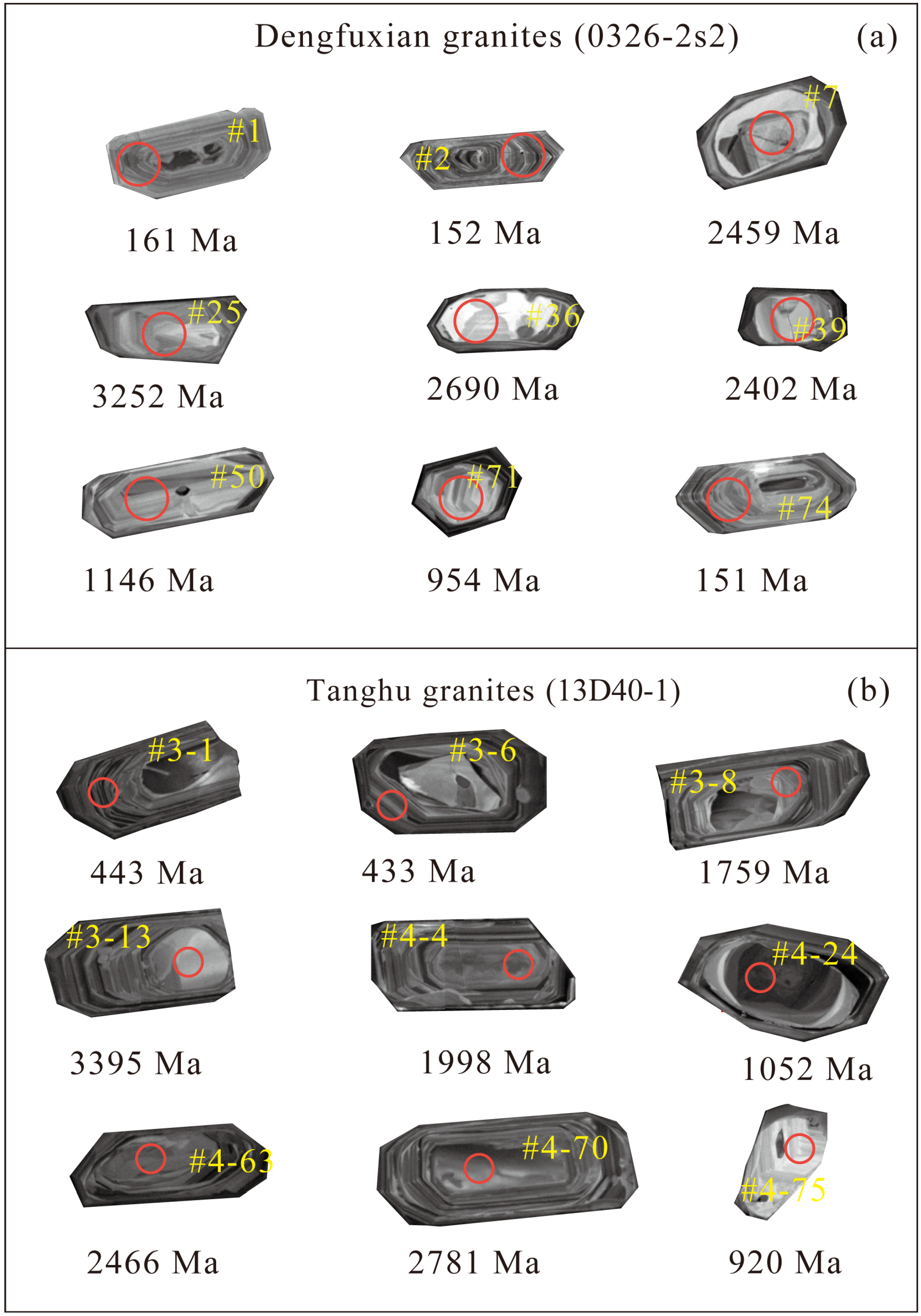
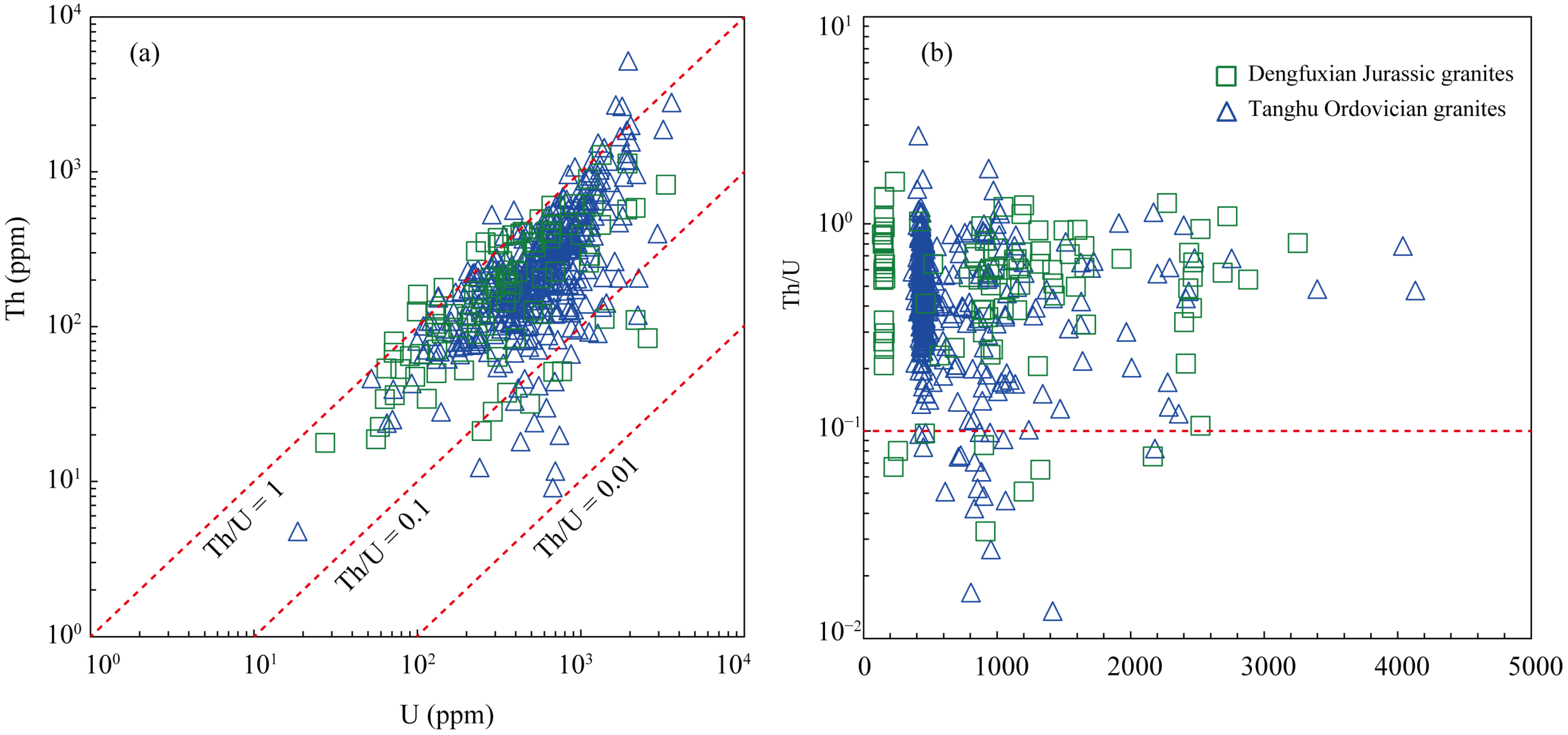



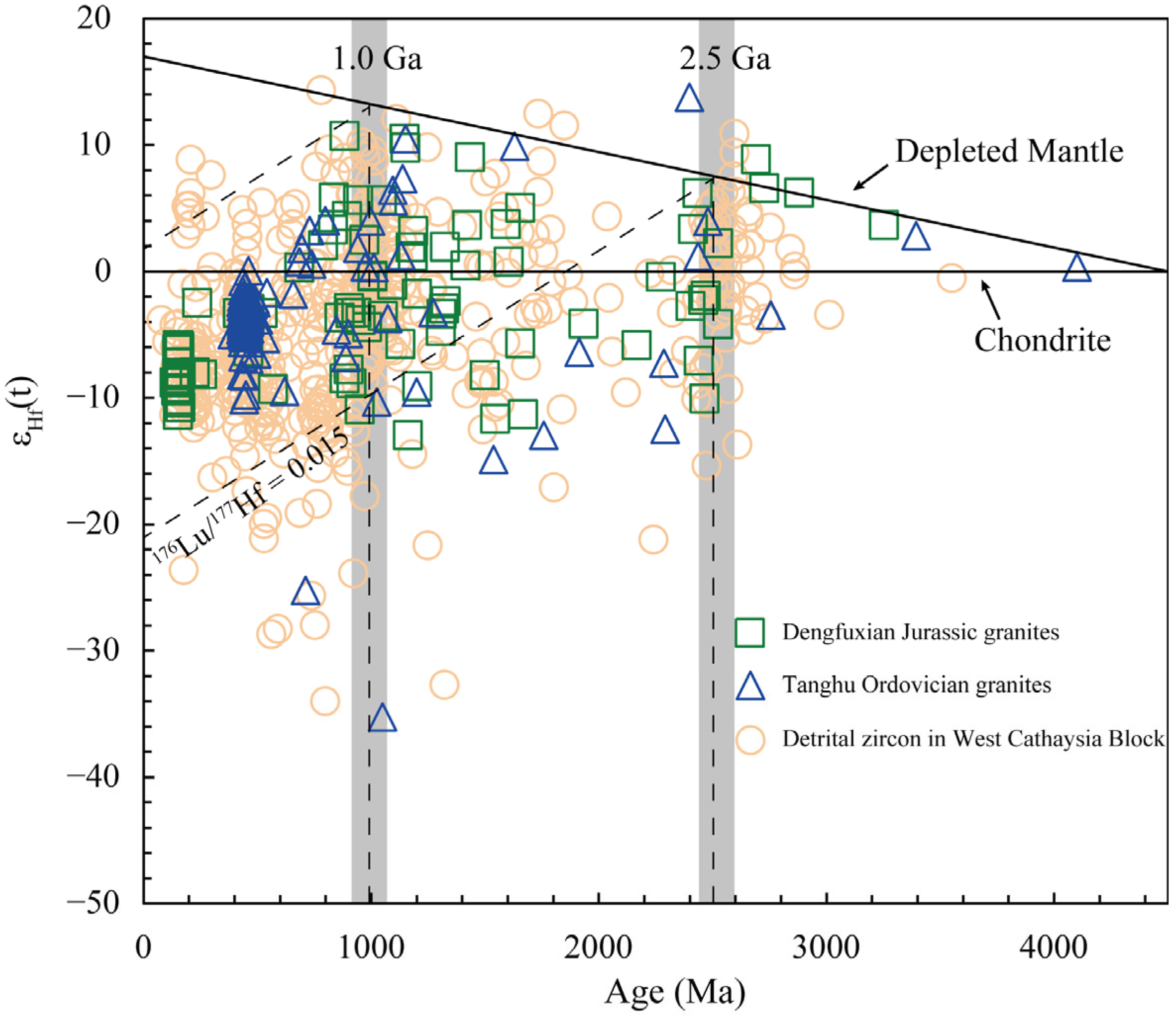
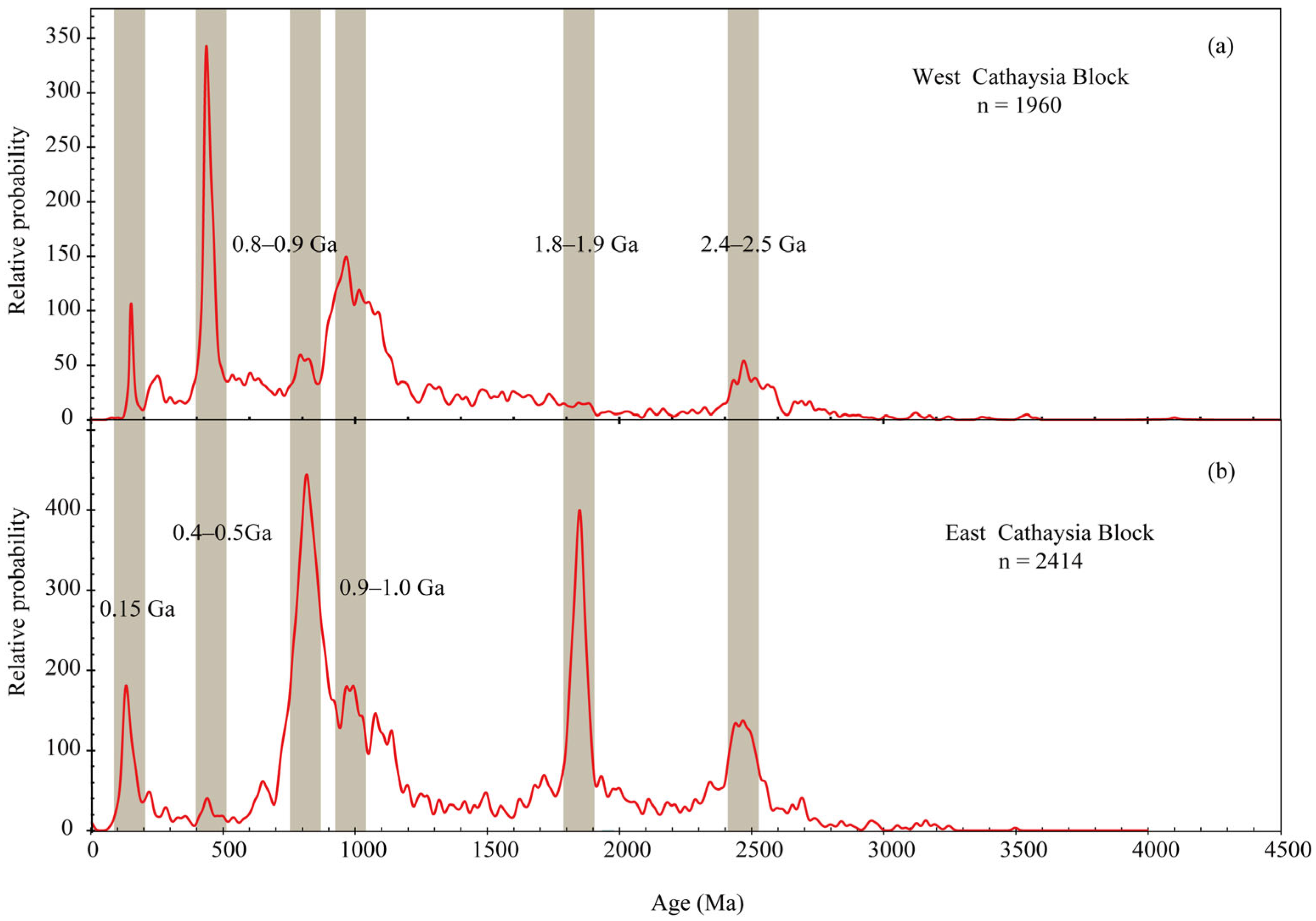
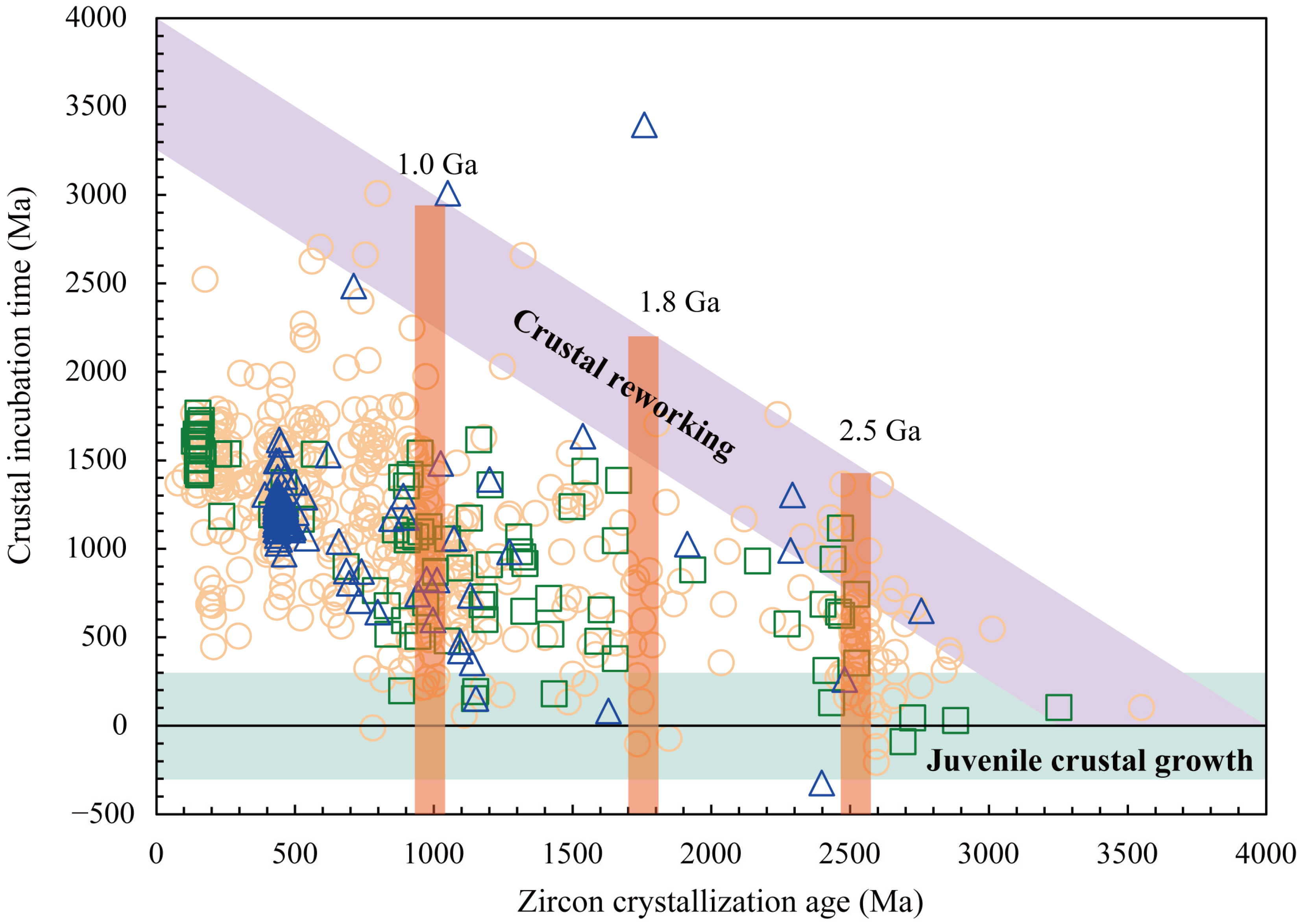
Disclaimer/Publisher’s Note: The statements, opinions and data contained in all publications are solely those of the individual author(s) and contributor(s) and not of MDPI and/or the editor(s). MDPI and/or the editor(s) disclaim responsibility for any injury to people or property resulting from any ideas, methods, instructions or products referred to in the content. |
© 2023 by the authors. Licensee MDPI, Basel, Switzerland. This article is an open access article distributed under the terms and conditions of the Creative Commons Attribution (CC BY) license (https://creativecommons.org/licenses/by/4.0/).
Share and Cite
Cao, J.; Lu, Y.; Liu, L.; Fu, J.; Xu, G.; Wu, Q.; Yang, S.; Qiu, X.; Zhang, Z. Insights into the Crustal Evolution and Tungsten Mineralization of the West Cathaysia Block: Constraints from the Inherited Zircons from the Mesozoic Dengfuxian and Paleozoic Tanghu Plutons, South China. Minerals 2023, 13, 550. https://doi.org/10.3390/min13040550
Cao J, Lu Y, Liu L, Fu J, Xu G, Wu Q, Yang S, Qiu X, Zhang Z. Insights into the Crustal Evolution and Tungsten Mineralization of the West Cathaysia Block: Constraints from the Inherited Zircons from the Mesozoic Dengfuxian and Paleozoic Tanghu Plutons, South China. Minerals. 2023; 13(4):550. https://doi.org/10.3390/min13040550
Chicago/Turabian StyleCao, Jingya, Youyue Lu, Lei Liu, Jianming Fu, Guofeng Xu, Qianhong Wu, Shengxiong Yang, Xiaofei Qiu, and Zunzun Zhang. 2023. "Insights into the Crustal Evolution and Tungsten Mineralization of the West Cathaysia Block: Constraints from the Inherited Zircons from the Mesozoic Dengfuxian and Paleozoic Tanghu Plutons, South China" Minerals 13, no. 4: 550. https://doi.org/10.3390/min13040550




